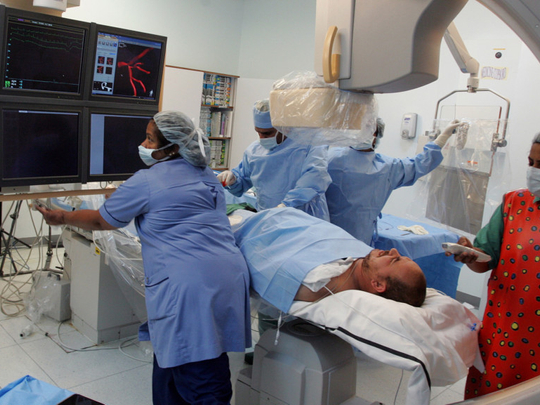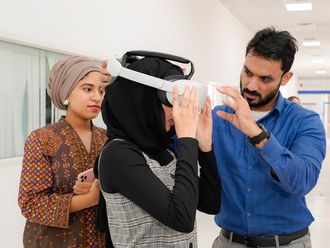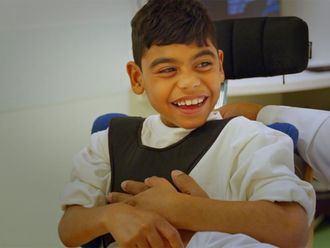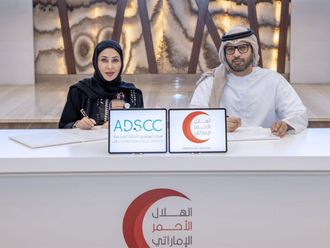
Dubai: A new central database will unify all medical records of five health-care facilities beginning Friday, said Dubai Health Authority on Wednesday.
Salama, which was originally announced under the patronage of Shaikh Hamdan Bin Mohammad Bin Rashid Al Maktoum Crown Prince of Dubai and Chairman of the Dubai Executive Council, in February 2016, centralises access to records for patients and doctors through the new portal across DHA health facilities. The launch day marks the first of the three phases with 1.4 million records going live at 3am on Friday.
Humaid Al Qutami, Chairman of the board and Director-General of DHA, said, “A third of DHA medical facilities will go live on the unified electronic medical record (EMR) system for its patients. These will include all patient records at Rashid Hospital, Al Barsha Medical Centre, the Airport Medical Centres, the Rehabilitation Centre at Al Safa and the Safa Dermatology Centre.
“This will mean that each and every patient registered in these centres will have one integrated medical file across all centres that will help the doctor know the treatment protocol a patient followed in the event of a hospital transfer and ensure homogenous treatment,” Al Qutami said.
Amani Al Jasmi, Director of DHA’s IT department, said Salama has so far unified about 1.4 million records and more than 12 million transactions have passed through this system. To ensure the smooth transition to the new electronic system, patients will be requested to provide their Emirates ID, medical card and health insurance details.
Commenting on the new system, Al Jasmi said: “We have been working on the EMR since 2016. The programme we follow is EPIC from the USA. The system is so efficient that it has multiple core applications. It integrates 25 applications through a single interface. Now the patient’s appointment, queue management, radiology, pharmacy, laboratory information system, dental records, information about the patient on biomedical devices such as dialysis machine, ventilator, cardiac machine etc will all be integrated through the EMR.”
Al Jasmi added that unifying records would help in more streamlined and better health-care delivery system that would ensure patient safety and accuracy.
Eventually, when all hospitals are linked, a “patient being moved from Rashid to Dubai Hospital will be ensured of getting the same treatment in Rashid or any other hospital as the record system will enable a homogenous treatment protocol”.
The roll-out of Salama is planned in three phases which is dubbed as “Waves”.
Wave 1 is being launched on Friday. Wave 2 will integrate all medical records at Dubai Hospital, DHA primary health centres and the Dubai Diabetes Centre by August 2017. Wave 3 will cover the Hatta and Latifa hospitals, all speciality clinics such as the Dubai Gynaecology and Fertility Centre, the Dubai Genetics Centre, the Thalassaemia Centre and other remaining clinics.
While Salama integrates medical records electronically in DHA-run health facilities, it is just two steps away from facilitating a national unified electronic medical record, said Al Jasmi. After these phases are over, Salama will integrate with the Nabid — the electronic health record (EHR), a national electronic medical record system. Work on it is ongoing and all private hospital records will be linked to it. In two years’ time, every resident will have one integrated medical record in the UAE. This will not only ensure accuracy in treatment protocols but also facilitate health insurance coverage.
How the system works
When a patient reports at a DHA hospital, he has to register using his Emirates ID and provide details of his health insurance coverage. Using these details, his electronic medical file with a unique number is generated.
Every single medical data regarding the patient is attached to the file electronically. These include a history of medical conditions, lab reports, diagnosis, treatment protocols, dental records and any other medical history.
If the patient is admitted to a DHA hospital, the feedback from monitors such as ventilators, dialysis machine, cardiac monitor etc is updated every two minutes on Salama so much so that the nurses at the station can see his latest report at a glance without having to visit his bedside.
When a patient is transferred to any other hospital, the unique number helps authorities there recall his file.
Source: DHA












